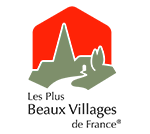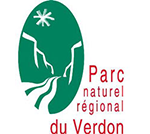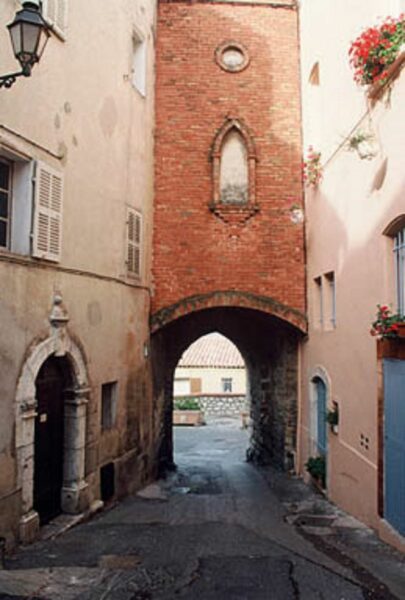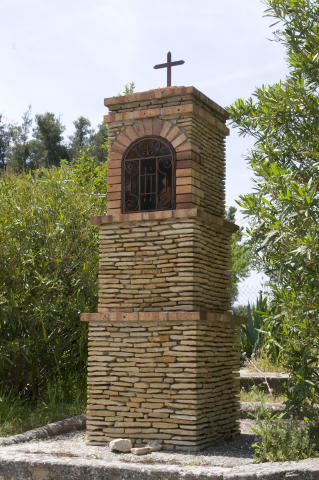Le Grand Portail and Le Portalet, two entrance porches to the village
Le Grand Portail and Le Portalet, gates cut into the ramparts surrounding the village, listed on the Inventaire supplémentaire des Monuments Historiques in 1939.
Market day: Saturday
Festivities:
> Saint-Clair Festival: January 2
> Medieval festival: September 2 and 3
Le Castellet is very large (4807 hectares) and consists of 5 villages quite distant from each other. From North to South, Camp du Castellet, Sainte-Anne du Castellet, Brûlat, the village and the Castellet and Plan du Castellet.
Contained in the walls with only two access doors, the village of Castellet is very representative of a medieval settlement. Upon the passage of the “great gate”, the castle, the church of the twelfth century, the laundry, the fountain and the winding alleys plunge us in the past, and evoke the peaceful life of the inhabitants. Leaving the castle by the “Trou de Madame”, we are presented with the vineyards of Brûlat and Sainte-Anne, lined with olive trees and pine forests. The white line of the massif of Sainte-Baume contrasts with the deep blue sky.
Everything here invites you to take a stroll: small steep streets that climb to the castle, the rich architecture of each house, craft shops to beautifully crafted products. Further down, the oratories invite us to discover these landscapes where silence contrasts with the continuous flow of the sea…




Divine invocations?
The town of Le Castellet is one of the villages of the Var which has the most shrines, they are still often located at cross roads and dedicated to the saints.
Which movie was filmed in Castellet?
Marcel Pagnol, seduced by the place, chose to film “The Baker’s Wife” here in 1938.

Le Grand Portail and Le Portalet, gates cut into the ramparts surrounding the village, listed on the Inventaire supplémentaire des Monuments Historiques in 1939.

Circuit Paul Ricard karting is a unique venue. It meets the same high standards as its big brother, the FORMULA 1 host circuit. Here, everything has been designed to make your experience a unique one.
Entirely dedicated to leisure and relaxation, karting is an extension of the spirit of the Circuit Paul Ricard, combining safety and aesthetics. Become a privileged driver at the wheel of high-performance "latest generation" karts and discover the quality of our facilities and infrastructures. Accessible to all, karting offers a wide range of formulas: rental, courses (children, adults, groups), challenge organization, training sessions, company seminars...at particularly attractive rates.
OUR TRACK
The Circuit Paul Ricard karting track is a unique venue. It meets the same high standards as its big brother, the FORMULA 1 host circuit. Here, everything has been designed to make your experience a unique one.
The 964m-long track is CIK international homologated (layout 1). It is floodlit at night, and offers seven different layouts (two of which are counter-clockwise). Safety features here are on a par with those on the Circuit Paul Ricard:
- Asphalt run-offs (blue stripes)
- TECPRO anti-collision barriers used in F1! (40% more effective than tire walls)
Our facilities comply with FIA (Fédération Internationale Automobile) and FFSA (Fédération Francaise de Sport Automobile) standards.

The commune of Le Castellet boasts some forty oratories.
This site groups together those that are most accessible.
They are generally located along roads and at crossroads, sometimes considered dangerous places,
- on a public road (74%);
- at crossroads,
- in fields,
- near a chapel or cemetery, to mark the memory.
With the exception of a single oratory on the northern slope of the medieval village, the oratories are mainly spread over the plain hamlets,
- Sainte-Anne has the largest number, notably along the "oratory path",
- Le Brûlat,
- Le Plan,
There are an exceptionally large number of oratories in our commune, and no one can quite put their finger on why.
Like menhirs and Roman steles, they were visible manifestations of the idea of inspiration towards heaven, in whose niches divinities were deposited.
Most of them are ancient, some dating back to the 19th century, and one of them is the oldest in the canton, dating back to the 17th century. This is the oratory dedicated to Notre-Dame de La Pinède in the Brûlat area, n°6.
Another is listed in the supplementary inventory of historic monuments by decree of October 7, 1931. This is the oratory dedicated to Saint-Antoine, Saint-Clair and Sainte-Anne, no. 2, located on the Tour du Bon estate.
These small monuments blend in perfectly with the rural landscape in which they have been placed. If they're not in the fields, they often stand in the shade of an old oak, near pines or an old grove.
Today, there are as many old oratories as there are new ones. The move from the public to the private domain changed the purpose of oratories. They are often functionalized. The mailbox, the lantern, the gate, the faucet or the name of the house are put there. We're witnessing a process of secularization.
We've gone from a monument that reassures and consoles, to a secularized monument.
2 Rue de la Poste
83330 LE CASTELLET
04 94 32 79 13
Place du Champ de Bataille
83330 Le Castellet
04 94 98 57 90